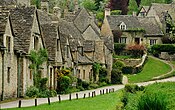Gloucestershire
Gloucestershire | |
|---|---|
Gloucester Cathedral, the village of Bibury in the Cotswolds, and the Second Severn Crossing in South Gloucestershire | |
 | |
| Coordinates: 51°50′N 2°10′W / 51.833°N 2.167°W | |
| Sovereign state | United Kingdom |
| Constituent country | England |
| Region | South West |
| Established | Ancient |
| Time zone | UTC+0 (GMT) |
| • Summer (DST) | UTC+1 (BST) |
| UK Parliament | List of MPs |
| Police | Gloucestershire Constabulary |
| Ceremonial county | |
| Lord Lieutenant | Edward Gillespie |
| High Sheriff | H C W Robinson (2023-2024) |
| Area | 3,150 km2 (1,220 sq mi) |
| • Rank | 16th of 48 |
| Population (2022)[1] | 947,174 |
| • Rank | 24th of 48 |
| Density | 301/km2 (780/sq mi) |
| Ethnicity | 91.6% White British |
| Non-metropolitan county | |
| County council | Gloucestershire County Council |
| Control | Conservative |
| Admin HQ | Gloucester |
| Area | 2,653 km2 (1,024 sq mi) |
| • Rank | 10th of 21 |
| Population (2022)[2] | 652,409 |
| • Rank | 18th of 21 |
| Density | 246/km2 (640/sq mi) |
| ISO 3166-2 | GB-GLS |
| GSS code | E10000013 |
| ITL | UKK13 |
| Website | gloucestershire |
| Unitary authorities | |
| Councils | South Gloucestershire Council |
| Districts | |
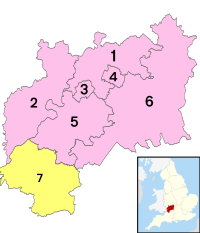 Districts of Gloucestershire Unitary County council area | |
| Districts | |
Gloucestershire (/ˈɡlɒstərʃər/ GLOST-ər-shər, /-ʃɪər/ -sheer; abbreviated Glos.)[3] is a ceremonial county in South West England. It is bordered by Herefordshire to the north-west, Worcestershire to the north, Warwickshire to the north-east, Oxfordshire to the east, Wiltshire to the south, Bristol and Somerset to the south-west, and the Welsh county of Monmouthshire to the west. The city of Gloucester is the largest settlement and the county town.
The county is predominantly rural, with an area of 3,150 square kilometres (1,220 sq mi) and a population of 916,212. After Gloucester (118,555) the largest distinct settlements are Cheltenham (115,940), Stroud (26,080), and Yate (28,350).[4] In the south of the county, the areas around Filton and Kingswood are densely populated and part of Bristol built-up area. For local government purposes Gloucestershire comprises a non-metropolitan county, with six districts, and the unitary authority area of South Gloucestershire. South Gloucestershire Council is a member of the West of England Combined Authority.
Gloucestershire is bisected by the river River Severn, which enters the county near Tewkesbury and forms a wide valley down its centre before broadening into a large tidal estuary. The hills to the east form the majority of the Cotswolds AONB, and the uplands to the west are part of the Forest of Dean and the Wye Valley AONB, which stretches into Wales.
Gloucestershire was likely established in the tenth century, and expanded to approximately its current borders in the eleventh. The county was relatively settled during the late Middle Ages, and contained several wealthy monasteries such as Tewkesbury, Gloucester, Hailes, and Cirencester; the Forest of Dean was also a major iron-producing region in this period. The city of Bristol became an independent county in 1373, by which point it was the third-largest city in England. Gloucestershire was not heavily industrialised during the Industrial Revolution, but the Port of Gloucester was expanded with new docks and the small Forest of Dean coalfield was exploited.
History
[edit]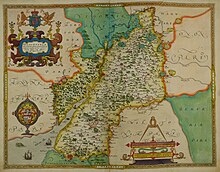
Gloucestershire is a historic county mentioned in the Anglo-Saxon Chronicle in the 10th century, though the areas of Winchcombe and the Forest of Dean were not added until the late 11th century.[5]
Gloucestershire originally included Bristol, then a small town. Members of local rural communities moved to the port city (as Bristol was to become), and Bristol's population growth accelerated during the industrial revolution. Bristol became a county in its own right, separate from Gloucestershire and Somerset, in 1373.[6] It later became part of the administrative County of Avon from 1974 to 1996.[7] Some northern parts of the county, including Long Marston and Welford-on-Avon, were transferred to Warwickshire in 1931.

Upon the abolition of Avon in 1996, the region north of Bristol became a unitary authority area of South Gloucestershire and is now part of the ceremonial county of Gloucestershire.[8]
In July 2007, Gloucestershire was subject to some of the worst flooding in recorded British history, with tens of thousands of residents affected. The RAF conducted the largest peacetime domestic operation in its history to rescue over 120 residents from flood-affected areas. The damage was estimated at over £2 billion.[9]
Geography and environment
[edit]Gloucestershire has three main landscape areas, a large part of the Cotswolds, the Royal Forest of Dean and the Severn Vale. The Cotswolds take up a large portion of the east and south of the county, The Forest of Dean taking up the west, with the Severn and its valley running between these features. The Daffodil Way in the Leadon Valley, on the border of Gloucestershire and Herefordshire surrounding the village of Dymock, is known for its many spring flowers, orchards, and woodland, which attracts many walkers. In the west, the Wye valley borders Wales.
Governance
[edit]Gloucestershire is a ceremonial county in South West England. Gloucestershire County Council's 53 seats are majority-controlled by the Conservatives, though the Liberal Democrats have a sizeable presence on the council.[10] The Council Leader is Mark Hawthorne. The County Council shares responsibility with six district councils: Tewkesbury, Forest of Dean, City of Gloucester, Cheltenham, Stroud and Cotswold.
The southernmost part of the county, South Gloucestershire is governed by South Gloucestershire Council, which is a unitary authority council independent of the county council but the unitary authority is still part of the ceremonial county. Previously, the area of South Gloucestershire was part of the county of Avon. Although Avon was abolished in 1996, some services in South Gloucestershire are still provided in conjunction with other former parts of Avon county, such as the Avon Fire and Rescue Service.[11] Since 2017, South Gloucestershire has been part of the West of England Combined Authority, which is under the directly elected mayor Dan Norris.[12]
There are six parliamentary constituencies in Gloucestershire, all of which are Conservative controlled as of the 2019 general election.[13] Due to the 2023 Periodic Review of Westminster constituencies, Gloucestershire will be combined with Wiltshire for parliamentary boundary purposes, allowing cross-county electoral divisions.[14]
Economy
[edit]This is a chart of trend of regional gross value added of Gloucestershire at current basic prices published (pp. 240–253) by Office for National Statistics with figures in millions of Pounds Sterling.
| Year | Regional Gross Value Added[15] | Agriculture[16] | Industry[17] | Services[18] |
|---|---|---|---|---|
| 1995 | 5,771 | 196 | 1,877 | 3,698 |
| 2000 | 8,163 | 148 | 2,677 | 5,338 |
| 2003 | 10,617 | 166 | 2,933 | 7,517 |
The following is a chart of Gloucestershire's gross value added total in millions of Pounds Sterling from 1997 to 2009 based upon the Office for National Statistics figures[19]
| Year | GVA (£ million) |
|---|---|
| 1997 | 7,167 |
| 1998 | 7,630 |
| 1999 | 8,034 |
| 2000 | 8,414 |
| 2001 | 8,947 |
| 2002 | 9,504 |
| 2003 | 10,117 |
| 2004 | 10,525 |
| 2005 | 10,680 |
| 2006 | 11,073 |
| 2007 | 11,563 |
| 2008 | 11,666 |
| 2009 | 11,452 |
The 2009 estimation of £11,452 million GVA can be compared to the South West regional average of £7,927 million.
Education
[edit]Secondary schools
[edit]Gloucestershire has mainly comprehensive schools with seven selective grammar schools; two are in Stroud, Stroud High School for girls and Marling School for boys, one in Cheltenham, Pate's Grammar, and four in Gloucester, Sir Thomas Rich's for boys (aged 11–18) and girls (aged 16–18, in the sixth form), and Denmark Road High School and Ribston Hall for girls and The Crypt which is mixed. There are 42 state secondary schools, not including sixth form colleges, and 12 independent schools, including Cheltenham Ladies' College, Cheltenham College and Dean Close School. All but about two schools in each district have a sixth form, but the Forest of Dean only has two schools with sixth forms. All schools in South Gloucestershire have sixth forms.
Higher and further education
[edit]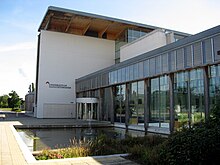
Gloucestershire has two universities, the University of Gloucestershire and the Royal Agricultural University, and four higher and further education colleges, Gloucestershire College, Cirencester College, South Gloucestershire and Stroud College and the Royal Forest of Dean College. Each has campuses at multiple locations throughout the county.
The University of the West of England also has three locations in Gloucestershire; an associate faculty (Hartpury College) specialising in animal behaviour and welfare, agricultural and sports-related courses in Hartpury, Gloucestershire; a regional centre at the Gloucester Docks, Alexandra Warehouse, specialising in Adult and Mental Health Nursing; and Frenchay Campus in South Gloucestershire.[20]
Towns and cities
[edit]Gloucestershire has one city and 33 towns:
Cities
[edit]Towns
[edit]The towns in Gloucestershire are:
- Berkeley
- Bradley Stoke
- Cheltenham
- Chipping Campden
- Chipping Sodbury
- Cinderford
- Cirencester
- Coleford
- Dursley
- Emersons Green
- Fairford
- Filton
- Kingswood
- Lechlade
- Lydney
- Minchinhampton
- Mitcheldean
- Moreton-in-Marsh
- Nailsworth
- Newent
- Northleach
- Painswick
- Patchway
- Quedgeley
- Stonehouse
- Stow-on-the-Wold
- Stroud
- Tetbury
- Tewkesbury
- Thornbury
- Winchcombe
- Wotton-under-Edge
- Yate
Suburban town of Stroud:
Town in Monmouthshire with suburbs in Gloucestershire:
Green belt
[edit]The county has two green belt areas, the first covers the southern area in the South Gloucestershire district, to protect outlying villages and towns between Thornbury and Chipping Sodbury from the urban sprawl of the Bristol conurbation. The second belt lies around Gloucester, Cheltenham, and Bishop's Cleeve, to afford those areas and villages in between a protection from urban sprawl and further convergence. Both belts intersect with the boundaries of the Cotswolds AONB.[21]
Transport
[edit]Railways
[edit]Gloucestershire once had a much larger railway network than it does now with over 100 stations in the county, the vast majority of which were closed during the Beeching cuts.[22] Nowadays, only 15 remain within the county, mostly concentrated on the CrossCountry NE-SW route and around the North Fringe of Bristol. Some stations have been re-opened in recent years; Cam and Dursley railway station opened in 1994, with Ashchurch for Tewkesbury opening three years later in 1997. Local campaign groups are also seeking to reopen several disused stations, including Charfield railway station in South Gloucestershire.[23]
Antiquities
[edit]There are a number of Roman remains scattered across the county, including the Eastgate Viewing Chamber in Gloucester and Chedworth Roman Villa.
There are a variety of religious buildings across the county, notably the cathedral of Gloucester, the abbey church of Tewkesbury (which is over 500 years old and has the tallest Norman tower in England),[24] and the church of Cirencester. Of the abbey of Hailes near Winchcombe, founded by Richard, Earl of Cornwall, in 1246, little more than the foundations are left, but these have been excavated and fragments have been brought to light.[25]

Most of the old market towns have parish churches. At Deerhurst near Tewkesbury and Bishop's Cleeve near Cheltenham, there are churches of special interest on account of the pre-Norman work they retain. There is also a Perpendicular church in Lechlade, and that at Fairford was built (c. 1500), according to tradition, to contain a series of stained-glass windows which are said to have been brought from the Netherlands. These are, however, adjudged to be of English workmanship.[26]
Other notable buildings include Calcot Barn in Calcot, a relic of Kingswood Abbey.[27] Thornbury Castle is a Tudor country house, the pretensions of which evoked the jealousy of Cardinal Wolsey against its builder, Edward Stafford, duke of Buckingham, who was beheaded in 1521. Near Cheltenham is the 15th-century mansion of Southam de la Bere, of timber and stone.[28] Memorials of the de la Bere family appear in the church at Cleeve. The mansion contains a tiled floor from Hailes Abbey. At Great Badminton is the mansion and vast domain of the Beauforts (formerly of the Botelers and others), on the south-eastern boundary of the county. Berkeley Castle at over 800 years old and the ruins of Witcombe Roman Villa at Great Witcombe are also notable heritage features.
There are several royal residences in Gloucestershire, including Highgrove House, Gatcombe Park, and (formerly) Nether Lypiatt Manor.
An annual "cheese-rolling" event takes place at Cooper's Hill, near Brockworth and the Cotswold Games occurred within the county.[29]
Places of interest
[edit]| Key | |
| Abbey/Priory/Cathedral | |
| Accessible open space | |
| Amusement/Theme Park | |
| Castle | |
| Country Park | |
| English Heritage | |
| Forestry Commission | |
| Heritage railway | |
| Historic House | |
| Places of Worship | |
| Museum (free/not free) | |
| National Trust | |
| Theatre | |
| Zoo | |


Places of interest in Gloucestershire include:
- Badminton House, residence of the Dukes of Beaufort

- Berkeley Castle, an example of a feudal stronghold.

- Beverston Castle

- Chavenage House

- Cheltenham Minster

- Clearwell Caves
- Dean Forest Railway

- Dyrham Park


- Edward Jenner's House


- Gloucester Cathedral

- Gloucestershire Warwickshire Railway

- Hailes Abbey


- Newark Park


- Owlpen Manor

- Rodborough and Minchinhampton Commons

- Snowshill Manor


- Sudeley Castle, burial place of Queen Catherine Parr, 6th wife and consort of King Henry VIII.

- Stanway House

- River Thames

- Rodmarton Manor

- Severn Bore

- St. John the Baptist Church, Cirencester

- Tewkesbury Abbey

- Tewkesbury Medieval Festival
- Tyndale Monument

- Wildfowl and Wetland Trust, Slimbridge
- Westbury Court Garden
- Westonbirt Arboretum
- Woodchester Mansion

Areas of countryside in Gloucestershire include:
Scenic Railway Line:
Media
[edit]Gloucestershire's only daily newspaper is the Western Daily Press, while The Citizen, which covers Gloucester, Stroud and the Forest of Dean, and the Gloucestershire Echo, which covers Cheltenham, Tewkesbury and the Cotswolds, were published daily but since October 2017 have been weekly publications. All three, along with free weeklies The Forester, Stroud Life, The Gloucester News and The Cheltenham and Tewkesbury News, are published by Local World. The Stroud News & Journal is a weekly paid-for newspaper based in Stroud. It is published in a tabloid format by Newsquest. Newsquest also produces the weekly Wilts and Gloucestershire Standard newspaper, which covers the southern and eastern parts of the county as well as the weekly Gloucestershire Gazette, which covers the south of the county and much of South Gloucestershire.[30]
Gloucester News Centre is an independent news website with news and information for Gloucestershire.[31]
Radio stations in Gloucestershire include BBC Radio Gloucestershire, BBC Radio Bristol (for South Gloucestershire), Heart West, Sunshine Radio and Greatest Hits Radio Gloucestershire.[32] There are also several community radio stations including Gloucester FM, Radio Winchcombe, Forest of Dean Radio, North Cotswold Community Radio, and Severn FM.
Local TV for the county is provided by BBC West and ITV West Country from Bristol, although in the northern extremes of Gloucestershire, BBC Midlands and ITV Central (West) from Birmingham covers this area.[33] Some eastern parts of the county (Cirencester and parts of the Cotswolds) receive BBC South and ITV Meridian from Oxford.
In popular culture
[edit]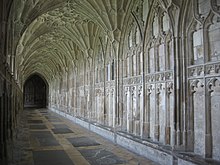
There are two well-known accounts of childhood in rural Gloucestershire in the early 20th century, Laurie Lee's Cider With Rosie and Winifred Foley's A Child in the Forest. Part of Mrs. Craik's novel John Halifax, Gentleman is set in Enderley, a thinly disguised Amberley, where she lived at the time of writing.[34] Most of the book is set in Nortonbury, easily recognisable as Tewkesbury.[35]
The county has also been the setting for a number of high-profile movies and TV series, including Die Another Day, the Harry Potter films and the BBC TV series Butterflies.[36]
"A Girl's Best Friend", the pilot for the proposed Doctor Who spin-off K-9 and Company, was filmed in Gloucestershire.[37] The setting is the fictional town of Moreton Harwood.[38] The fictional town of Leadworth in Doctor Who is in Gloucestershire.[39] It is the home of companions Amy Pond, Rory Williams and River Song in their childhoods and young adulthoods.[40] Additionally, the 2020 episode "Fugitive of the Judoon" was set and filmed at Gloucester Cathedral.[41]
A fictional Brimpsfield was the village, home of Peter and Abby Grant, in the 1970s BBC TV series Survivors, with a railway connection to London.[42]
Witcombe Festival is an annual music festival held in Brockworth. As well as music, the three-day festival has it roots deep in cider. The festival consists of four stages and has been headlined by Dizzee Rascal, Plan B, Sigma, Ella Eyre, Example, Wiley, Heather Small, Lethal Bizzle and Tinchy Stryder.[43]
The Romano/Celtic temple ruins in Lydney Park contributed to J.R.R. Tolkien's description of The Shire in his Middle-earth Legendarium.[44]
Animals
[edit]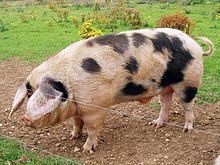
The famous Gloucestershire Old Spots pig is named for Gloucestershire and is historically associated with the county.[45] Sheep roam widely in the Forest of Dean. The Forest of Dean and the Wye Valley also have wild boar.[46]
Gloucester cattle, a rare[47] breed, can still be found in and around Gloucestershire.[48] They can be recognised by the white stripe that runs down the centre of their backs to the tip of their tails. The cattle are famous for producing milk for both Single Gloucester and Double Gloucester cheeses.[49]
See also
[edit]- Custos Rotulorum of Gloucestershire – Keepers of the Rolls
- Diocese of Gloucester
- Gloucestershire (UK Parliament constituency) – Historical list of MPs for Gloucestershire constituency
- Gloucestershire County Cricket Club
- Gloucestershire Police and Crime Commissioner
- Gloucestershire Regiment
- High Sheriff of Gloucestershire
- Lord Lieutenant of Gloucestershire
- List of people from Gloucestershire
- List of hills of Gloucestershire
- Royal Gloucestershire Hussars
- West Country dialects
- Category:Grade I listed buildings in Gloucestershire
References
[edit]- ^ "Mid-2022 population estimates by Lieutenancy areas (as at 1997) for England and Wales". Office for National Statistics. 24 June 2024. Retrieved 26 June 2024.
- ^ "Mid-Year Population Estimates, UK, June 2022". Office for National Statistics. 26 March 2024. Retrieved 3 May 2024.
- ^ "Abbreviations". Oxford English Dictionary. Archived from the original on 19 June 2020. Retrieved 28 June 2020.
- ^ "Towns and cities, characteristics of built-up areas, England and Wales: Census 2021". Office for National Statistics. 2 August 2023. Retrieved 6 December 2023.
- ^ "Forest of Dean: Introduction". A History of the County of Gloucester: Volume 5, Bledisloe Hundred, St. Briavels Hundred, the Forest of Dean. Victoria County History: 285–294. Archived from the original on 3 April 2020. Retrieved 3 May 2021 – via British History Online.
- ^ Liddy, Christian Drummond (2005). War, Politics and Finance in Late Medieval English Towns: Bristol, York and the Crown, 1350–1400. Boydell & Brewer. ISBN 978-0-86193-274-0. Archived from the original on 3 May 2021. Retrieved 3 May 2021.
- ^ "Local Government Bill (Hansard, 16 November 1971)". Parliamentary Debates (Hansard). 16 November 1971. Archived from the original on 11 May 2011. Retrieved 7 March 2009.; "The Avon (Structural Change) Order 1995". opsi.gov.uk. Archived from the original on 13 November 2012. Retrieved 27 January 2013.
- ^ Robbins, Bill (1997). "South Gloucestershire: The Transition to Unitary Authority Status". Journal of Integrated Care. 5 (1): 18–23. doi:10.1108/14769018199700004.
- ^ "Flood crisis grows as rivers rise". BBC News. 23 July 2007. Archived from the original on 3 September 2017. Retrieved 15 February 2013.
- ^ "Election results by party, 6 May 2021". Gloucestershire County Council. 6 May 2021. Retrieved 9 June 2021.
- ^ "About us". Avon Fire & Rescue. Retrieved 12 May 2016.
- ^ "West of England £1bn devolution deal announced in Budget". BBC News. 16 March 2016. Retrieved 17 March 2016.
- ^ Watson, Christopher; Uberoi, Elise; Loft, Philip (17 April 2020). "General election results from 1918 to 2019". Archived from the original on 17 April 2020.
- ^ "Gloucestershire electoral boundary changes 'a dog's dinner'". BBC News. 9 June 2021. Retrieved 8 October 2021.
- ^ Components may not sum to totals due to rounding
- ^ includes hunting and forestry
- ^ includes energy and construction
- ^ includes financial intermediation services indirectly measured
- ^ "{title}". Archived from the original on 24 September 2015. Retrieved 11 November 2014.
- ^ "Getting to and from UWE Bristol campuses". University of the West of England. Archived from the original on 16 April 2021. Retrieved 3 May 2021.
- ^ "Gloucester, Cheltenham and Tewkesbury Joint Core Strategy 2011 – 2031". Gloucester City, Cheltenham Borough and Tewkesbury Borough. Retrieved 3 May 2021.
- ^ "The long lost railways stations of Gloucestershire". February 2020.
- ^ "Details of new railway station near Bristol and when it will open". 23 November 2021.
- ^ "History". Tewkesbury Abbey. Archived from the original on 23 January 2021. Retrieved 3 May 2021.
- ^ "Hailes Abbey". English Heritage. Archived from the original on 27 October 2019. Retrieved 3 May 2021.
- ^ "Fairford, St Mary's Church". Britain Express. Archived from the original on 28 October 2020. Retrieved 3 May 2021.
- ^ "C. Michael Hogan and Amy Gregory, History and Architecture of Calcot Manor, Lumina Technologies, prepared for Calcot Manor, July 5, 2006". Archived from the original on 29 March 2007. Retrieved 20 December 2006.
- ^ "Simon Thurgood Images: Out and About in Gloucestershire". simonthurgoodimages.co.uk. Archived from the original on 24 October 2019. Retrieved 24 October 2019.
- ^ "Cotswold Olimpicks". Cotswold Olimpicks. Archived from the original on 3 May 2021. Retrieved 3 May 2021.
- ^ "Newsquest Gloucestershire". Newsquest. Archived from the original on 24 July 2016. Retrieved 3 May 2021.
- ^ "Gloucester News Centre". Gloucester News Centre. Archived from the original on 25 March 2021. Retrieved 3 May 2021.
- ^ "Listen to 7 radio stations in Gloucester online". Radio net. Archived from the original on 25 September 2020. Retrieved 3 May 2021.
- ^ "Local news area". BBC. Archived from the original on 16 April 2021. Retrieved 3 May 2021.
- ^ "Minchinhampton – Introduction | A History of the County of Gloucester: Volume 11 (pp. 184–190)". British History Online. 22 June 2003. Archived from the original on 25 October 2012. Retrieved 15 February 2013.
- ^ "Literary Tewkesbury". Tewksbury History. Archived from the original on 3 May 2021. Retrieved 3 May 2021.
- ^ 'Gloucestershire TV and Movie Locations' at Gloucestershire on Screen Archived 22 August 2010 at the Wayback Machine
- ^ "Doctor Who Locations Guide: K9 and Company". Doctorwholocations.net. Archived from the original on 31 December 2013. Retrieved 15 February 2013.
- ^ "K-9 and Company". Doctor Who Reference Guide. Archived from the original on 10 May 2012. Retrieved 29 December 2013.
- ^ Moffat, Steven (3 April 2010). "The Eleventh Hour". Doctor Who. Series 5. Episode 1. BBC. BBC One.
- ^ Moffat, Steven (3 April 2010). "The Eleventh Hour". Doctor Who. Series 5. Episode 1. BBC. BBC One.
Moffat, Steven (26 June 2010). "The Big Bang". Doctor Who. Series 5. Episode 13. BBC. BBC One.
Moffat, Steven (27 August 2011). "Let's Kill Hitler". Doctor Who. Series 6. Episode 8. BBC. BBC One. - ^ Norris, Phil (21 January 2020). "Doctor Who in Gloucester: This is probably the strangest thing you'll ever see in a cafe". Gloucestershire Live. Archived from the original on 26 January 2020. Retrieved 3 May 2021.
- ^ "The Fourth Horseman". Survivors Series. Archived from the original on 20 February 2020. Retrieved 3 May 2021.
- ^ Gibbon, Tom (30 May 2019). "Fix up look sharp! Dizzee Rascal tops incredible line-up for Witcombe Cider Festival 2019". Gloucestershire Live. Archived from the original on 31 May 2019. Retrieved 23 August 2020.
- ^ "Gloucestershire films – JRR Tolkien and Lydney Park's links with Lord of the Rings". BBC. 24 September 2014. Retrieved 16 March 2022.
- ^ "Gloucestershire Old Spots". Rbst.org.uk. Archived from the original on 27 February 2014. Retrieved 23 February 2014.
- ^ Vidal, John (5 April 2013). "Hundreds of wild boars face cull in Forest of Dean". The Guardian. London. Archived from the original on 2 March 2014. Retrieved 23 February 2014.
- ^ "Gloucester" (PDF). Rare Breeds Survival Trust. 2011. Archived from the original (PDF) on 27 February 2014. Retrieved 23 February 2014.
- ^ "Gloucester Cattle Society". gloucestercattle.org.uk. Archived from the original on 27 February 2014. Retrieved 23 February 2014.
- ^ "Gloucester cattle breed at increased risk of extinction". BBC News. 11 April 2021. Archived from the original on 11 April 2021. Retrieved 3 May 2021.
Further reading
[edit]Rudder, Samuel. (1779) A New History of Gloucestershire. Reprint: Nonsuch Publishing, 2006. ISBN 1-84588-023-4 (Free download of original here: A New History of Gloucestershire)
External links
[edit] Media related to Gloucestershire at Wikimedia Commons
Media related to Gloucestershire at Wikimedia Commons Gloucestershire travel guide from Wikivoyage
Gloucestershire travel guide from Wikivoyage- Gloucestershire County Council Local government web site
- Visit Gloucestershire Gloucestershire Guide
- Images of Gloucestershire at the English Heritage Archive


